Omakase @ Barracks Row. 522 Eighth St., SE.
If you’ve heard of just one sushi master, it’s probably Jiro Ono, the craftsman featured in the documentary Jiro Dreams of Sushi. After being featured in the movie, Ono’s protege Daisuke Nakazawa decamped to the US to open Sushi Nakazawa, a luxurious downtown New York omakase bar which later spawned a DC sibling. Now, Ricky Wang—the former senior sushi chef of DC’s Nakazawa—has opened his own place: Omakase @ Barracks Row. As a student of Nakazawa and DC head chef Masaaki “Uchi” Uchino, Wang is the third generation in the tradition that began at Sukiyabashi Jiro.
“I respect them a lot,” Wang says. “Our relationship was master and student, but now we’ve become friends.”
Wang’s first standalone omakase restaurant opened on November 9 on Barracks Row, above Han Palace, a Chinese restaurant owned by his business partner Chris Zhu. His 21-course omakase—served at a minimalist 14-seat marble bar—goes for $180 per person.
Chinese-born Wang first got to know the sushi tradition after moving to the US two decades ago. In 2018, Nakazawa and Uchino brought him on as opening sushi chef at Sushi Nakazawa’s branch in what was then the Trump International Hotel (Nakazawa and restaurateur Alessandro Borgognone were criticized for collaborating with the Trump business; Andrés had backed out of a deal in the same hotel). Wang later worked at José Andrés’s Minibar and Barmini.
Before opening Omakase @ Barracks Row in earnest, Wang hosted a series of pop-up omakase dinners at Ginza, Zhu’s karaoke bar next door.
Though Wang’s approach to nigiri is refined and fairly traditional, he has carved out some signatures. To flavor his koshihikari rice blend, he uses a mixture of red akasu vinegars, made from sake lees, as opposed to the white rice vinegars that have become more standard (Akasu vinegar is far richer).
“For my tasting palette, red vinegar has more umami to it,” Wang says. “The reason why I blend them is that I try to find a balance I can use for all my sushi courses.”

Then there’s Wang’s fish selection, which is highly seasonal and diverse, and might include some selections you’ve never tried before. At the moment, he’s serving bioluminescent firefly squid, ikura roe from female keta salmon alongside nigiri made with the male, and crunchy Japanese freshwater crab that he compares to kettle-cooked chips. Those join recognizable classics like otoro (fatty tuna) and less typical nigiri arrangements like three to five dainty, metallic-looking filets of the anchovy-like kibinago (silver-stripe round herring), layered like shingles over rice.
Some of Wang’s innovations reflect his Chinese background: a Wagyu beef shumai, accompanied by a pungent mustard foam, is often one of the omakase courses.
In the near future, Wang and his service director Gabriel Enjiamo plan to debut an additional omakase bar on the restaurant’s third floor and an extensive sake program. The restaurant’s nondescript white-and-gray interior signifies that the real focus is the fish and Wang’s attentive “museum tour guide” approach to the omakase experience, Enjiamo says. Wang prefers to talk to guests about what they liked and see their reactions to his food.
Walking diners through the menu, Wang focuses on sustainability, pointing out that bones and scraps from the fish are used to deepen the flavor of the miso soup. One of Wang’s first courses, a smoked corn chawanmushi custard, also makes good use of leftovers through an ad hoc arrangement: an employee at the karaoke bar next door keeps chickens at a farm outside DC, and uses the corn leftovers to feed them, in exchange for the eggs that Wang uses for the same dish.


















